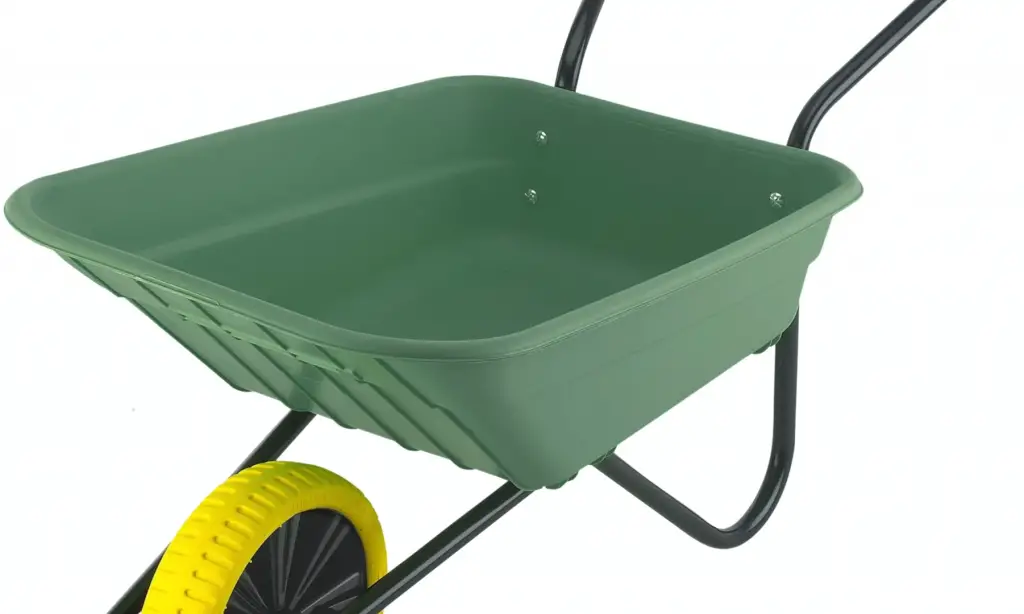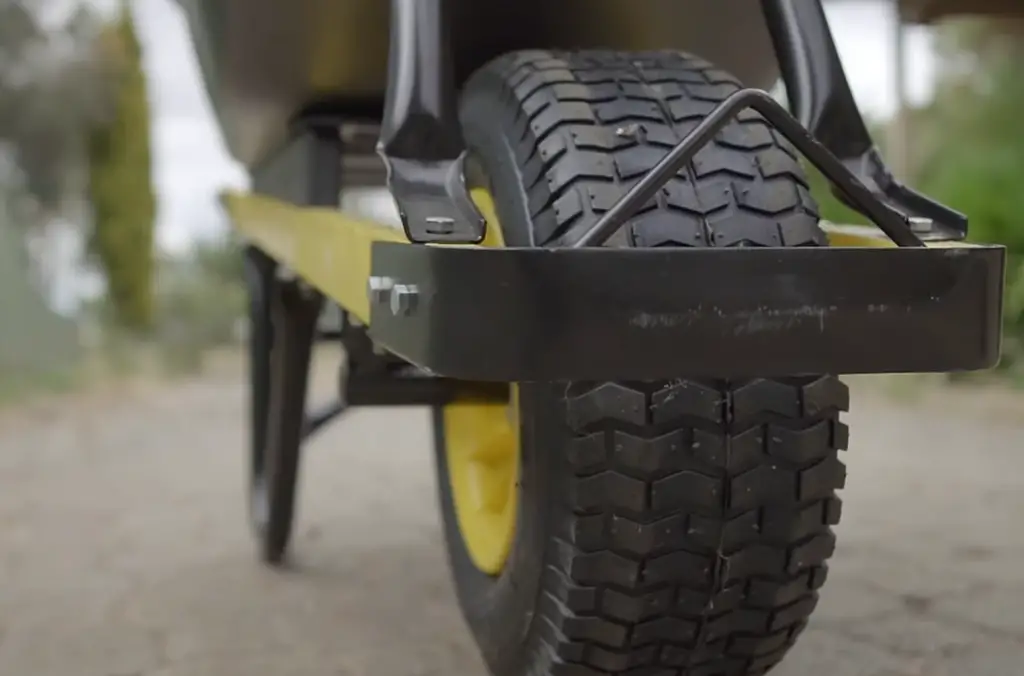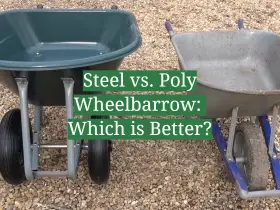A wheelbarrow is a handy tool to have around the house, but how much weight can it actually hold? Many people are unsure of the answer to this question, so we decided to do some research and put together a comprehensive guide on how much weight a wheelbarrow can hold. Keep reading for answers to frequently asked questions and useful tips on how to use your wheelbarrow safely!
Wheelbarrow Dimensions
The size and type of wheelbarrow you have will play a large role in how much weight it can hold. For example, a standard single-wheel plastic wheelbarrow typically has an average capacity of 100 lbs, while two-wheeled steel wheelbarrows can support up to 350 lbs. It’s important to take into account the dimensions of your wheelbarrow when considering how much it can carry. The longer the bed, the more weight it can handle since there is less chance of it tipping over. [1]
Wheelbarrow Carrying Weight
The amount of weight a wheelbarrow can carry depends on several factors, including the material it’s made from, its size, and how much you’re willing to strain yourself in order to lift it.
It is also important to consider that even if your wheelbarrow is rated for a certain weight limit, this does not necessarily mean that it will stay stable when you’re pushing it around or moving through an uneven surface. A full load should always be well-balanced in the tray so as to avoid tipping over or breaking out of the wheelbarrow. [1]

Conversion
You may be wondering how much weight a wheelbarrow can hold in different measurements. The conversion to figure out the answer is as follows: one cubic foot of material weighs roughly between 40 and 100 pounds (depending on the material). For example, if you have a six-cubic-foot wheelbarrow, it will hold between 240 and 600 pounds. [2]
The standard size of a wheelbarrow
The standard size of a wheelbarrow depends on its intended use. For general-purpose garden work, the most common size is between 35 and 50 liters. If you’re going to be hauling heavy loads, like sand or gravel, it’s best to opt for the larger capacity models that range from 75 to 120 liters. [3]
How many barrows are in a cube?
The answer to this question depends on the size of your wheelbarrow.
It’s worth noting that the exact capacity of any given wheelbarrow varies greatly depending on its design and construction. Some models are specifically designed to carry heavier loads than others, so it’s important to check with the manufacturer for an accurate estimate before loading up your wheelbarrow. [3]
How many wheelbarrows are in a cube?
The amount of wheelbarrows that fit in a cube depends on the size of the wheelbarrow, as well as the size of the cube. A medium-sized wheelbarrow can typically hold 1 cubic meter (1000 liters) of material, so 2 medium-sized wheelbarrows would fit into a single 2m x 2m x 1m cube. However, if you have larger or smaller wheelbarrows, then this number can vary significantly.
It’s important to remember that each wheelbarrow has its own maximum capacity, so you should always make sure that your chosen wheelbarrow is rated to handle the weight of whatever it will be carrying – no matter how many you plan to place within a single cube. Paying attention to these details can help ensure that you don’t overload your wheelbarrows, which could lead to accidental injury or damage to the wheelbarrow. [3]
How many wheelbarrows are in a ton?
It takes about 20 wheelbarrows to fill a ton of material. That said, the capacity of your wheelbarrow and the weight it can carry will be determined by several factors. Generally speaking, most standard wheelbarrows can carry up to 200 pounds or 90 kilograms when filled with soil, sand, gravel, etc.
Wheelbarrows designed for heavier loads may hold more – sometimes up to 350 pounds (or 160kg) – but that depends on how much weight the individual wheelbarrow is designed and built to handle safely. [3]

How much does a wheelbarrow hold?
The amount of weight that a wheelbarrow can hold depends on several factors, including the type and size of the wheelbarrow, its construction materials, and the number of handles. Generally speaking, a basic single-wheel metal wheelbarrow will hold up to 300 lbs or 136 kg. But some specialty models are capable of supporting up to 1,000 lbs or 454 kg! [3]
What is the volume of a wheelbarrow?
The volume of a wheelbarrow varies depending on the size and type you have. Most wheelbarrows are about 35″ long, 22″ wide, and 16″ high. The typical volume is somewhere between 8 to 10 cubic feet. The capacity of the wheelbarrow will also depend on its weight limit, so make sure you consider that as you purchase your wheelbarrow. [3]
How to find the volume of a wheelbarrow?
Knowing the volume of your wheelbarrow can help you estimate how much weight it can safely carry. To find the volume, start by measuring the length and width of the inside of your wheelbarrow. Once you have these measurements, multiply them together to get an approximate total cubic capacity. This number will be useful in determining how much material (i.e., soil, gravel) your wheelbarrow can carry without becoming overloaded or damaged.
To calculate the approximate weight capacity for a load, divide the cubic capacity by 0.0625 and then multiply that result by 62.4 pounds per cubic foot (the average weight of a cubic foot of soil). This calculation should give you a good idea as to how much weight your wheelbarrow can safely carry. It is important to remember, however, that this calculation does not account for any additional weight from the handles, sides, or other features of the wheelbarrow itself. [3]
The volume of the standard wheelbarrow
It’s important to take into consideration this capacity when you are deciding how much weight it can hold. [3]
The volume of the wheelbarrow in liters
When it comes to determining how much weight a wheelbarrow can withstand, one important factor is the volume of the wheelbarrow in liters. This will vary based on the size of the wheelbarrow you have – smaller ones are more lightweight and may not hold as much weight, while larger ones have higher capacity. Generally speaking, most standard-sized wheelbarrows will hold between 50 and 80 liters of material. [3]
The volume of a metal wheelbarrow
The common garden wheelbarrow may look small, but in fact, it can hold quite a bit of material. The volume of a typical metal wheelbarrow is around 6 to 7 cubic feet (170 – 198 liters). This means that the average wheelbarrow can carry up to 300 pounds (136 kg) when filled with garden soil, mulch, or other materials that are commonly used around the house and garden. [3]
The volume of 1 wheelbarrow in a cubic meter
For many people, the first question they have when it comes to finding out how much weight a wheelbarrow can hold is what is the volume of a typical wheelbarrow in cubic meters. This is an important piece of information as it enables you to calculate the total capacity of the wheelbarrow.
The average volume of one standard-sized construction-type wheelbarrow (or garden cart) is around 0.9 cubic meters or 32 cubic feet. With this figure, you can now do some simple calculations to work out the maximum load capacity for your specific type and model of the wheelbarrow. [3]
How many bags of concrete can I mix in a wheelbarrow?
If you are planning on mixing concrete in a wheelbarrow, the amount of concrete you can mix depends on the size and weight capacity of your wheelbarrow. Generally speaking, a regular-sized wheelbarrow can hold up to 3 bags of concrete at once. However, if your wheelbarrow is rated for higher weight capacities, it may be able to handle more than 3 bags.
Before attempting to mix multiple bags of concrete in a wheelbarrow, make sure that your wheelbarrow is stable enough to support the load. Always keep an eye on the balance so that you don’t overfill one side and cause the entire contents to spill out when moving it around. [3]
FAQ
How heavy is a wheelbarrow full of concrete?
A wheelbarrow full of concrete can be quite heavy, typically ranging anywhere from 180 to 270 pounds! This weight is dependent on the size of the wheelbarrow and how much concrete is loaded into it. Remember that when carrying a heavy load such as this one, it’s important to lift with your legs and not your back in order to prevent injury.
How many kg fit in a wheelbarrow?
The maximum amount of weight a wheelbarrow can hold depends on the size and quality of the wheelbarrow as well as the type of material that is being loaded into it. Generally, a standard-sized wheelbarrow will be able to carry up to 80 kg or 176 pounds. If you opt for an extra-large wheelbarrow, then you may be able to accommodate more than this.
How many wheelbarrows of sand make a ton?
Depending on the size and weight of your wheelbarrow, a ton of sand could require anywhere from 13 to 30 full loads or trips. To figure out how many wheelbarrows you need for a ton of sand, calculate the total capacity of your wheelbarrow by multiplying its length (in feet) by its width (in feet). Then, divide the weight of a ton (2,000 pounds) by the total capacity. The result will be the number of trips or full loads needed to move one ton of sand.
How many bags of cement can you mix in a wheelbarrow?
The capacity of a wheelbarrow will depend on the size and quality of the wheelbarrow as well as the type of material that is being loaded into it. Generally, a standard-sized wheelbarrow will be able to carry up to six 80-pound bags of cement or four cubic feet. If you opt for an extra-large wheelbarrow, then you should be able to accommodate more than this.
What’s the best way to mix concrete in a wheelbarrow?
Mixing concrete in a wheelbarrow is easy if you have the right tools and materials. Before you begin, make sure you have safety goggles, rubber gloves, and a shovel on hand to protect yourself from any debris that may be stirred up during the mixing process. Start by adding half of the required water to your wheelbarrow, then add all of your dry ingredients such as Portland cement and sand. Finally, mix everything together with your shovel until it’s thoroughly combined (typically around five minutes). When finished, your concrete should be moist but not too wet or dry.

What is the best wheelbarrow to mix concrete?
The best wheelbarrow for mixing concrete is one with a heavy-duty steel tray and thick rubber tires. This type of wheelbarrow will be able to handle the weight of the concrete without buckling or breaking and will also have enough capacity to hold all of your tools, materials, and other supplies while you’re working. If possible, look for a model that offers adjustable handles as this will make it easier to maneuver around tight spaces when carrying a heavy load.
What happens when you mix sand and cement?
When sand and cement are mixed together, a chemical reaction takes place that results in the formation of new compounds called hydrated products. These hydrated products act as binding agents, helping to hold the concrete together and giving it its strength. The ratio of sand to cement will affect the strength and durability of your finished product, so make sure you use the correct ratio when mixing your ingredients.
Does extra cement make concrete stronger?
Adding extra cement to your concrete mix will not necessarily make it stronger than if you used the recommended ratio of ingredients. Concrete strength depends on a combination of factors such as the type of cement, the amount and type of aggregate (sand or gravel), and the water-to-cement ratio. Although adding more cement can increase the density and strength of concrete, too much can also cause shrinkage cracks which will weaken your finished product.
Useful Video: How to Find Volume of Wheelbarrow?
Conclusion
When using a wheelbarrow, it’s important to remember that the safe weight limit will vary depending on the type and size of the wheelbarrow. It’s always best to err on the side of caution and not overload your wheelbarrow with too much weight. By closely following manufacturer guidelines, carefully loading your supplies evenly, and avoiding any sudden movements, you can ensure that your wheelbarrow stays in good condition for years to come. With these tips in mind, you should be able to accurately gauge how much load your wheelbarrow can handle so that you can make sure your loads are as light as they need to be while still completing all of your tasks efficiently. Good luck!
References:
- https://www.jwconstructionanddesign.com/how-much-weight-can-a-wheelbarrow-hold/
- https://simplydumpit.com/blogs/news/how-much-weight-can-a-wheelbarrow-hold
- https://civilsir.com/volume-of-a-wheelbarrow/










Leave a Reply
View Comments